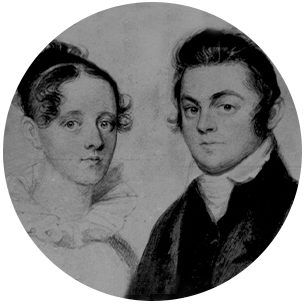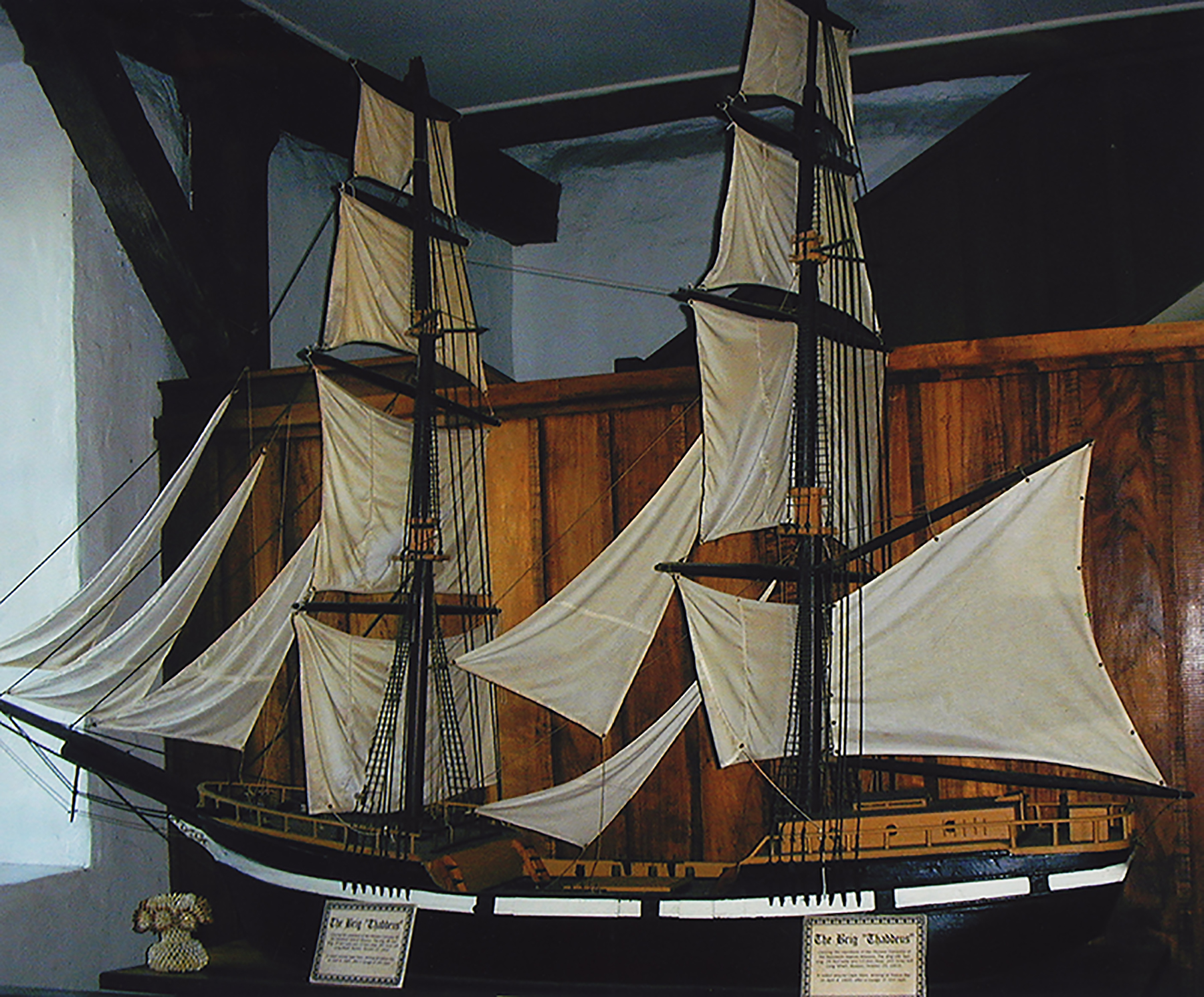On October 23, 1819, the fourteen men and women of the first company to Hawai‘i boarded the brig Thaddeus, anchored in Boston Harbor. They were joined by four Hawaiian men, three as members of the mission and a prince returning home to Kaua‘i. Six of the missionary couples were newlyweds, having married in the weeks prior so they could join the mission (ABCFM required missionaries to be married). The seventh couple brought their five children, ages one to twelve.

Captain Andrew Henri Blanchard, First Officer James Hunnewell
85 feet long, 24 feet wide, 13 feet deep | 241 tons • Departed Long Wharf, Boston, on October 23, 1819 • Sighted Mauna Kea on March 30, 1820 • Disembarked at Kailua, Hawai‘i Island, on April 4, 1820 • Voyage of 164 days (18,000 miles) around Cape Horn, Chile
Brig Thaddeus. Model built by Pacific Fleet Command in 1934. Mokuaikaua Church, Kona.
Photo courtesy of Christopher Cook.
The Americans were a diverse group: two ministers, a farmer, a doctor, teachers and a printer. While recruited from different churches, towns and schools in New England, they shared a staunch belief in the importance of bringing salvation to a “heathen nation.” They did not know what they might find in Hawai‘i, much less the dramatic changes that had just taken place there. Yet these changes would tip the scales of history irrevocably in their favor.

Rev. Hiram and Mrs. Sybil Bingham
Hiram Bingham was inspired by ʻŌpūkahaʻia’s story to visit the Foreign Mission School where he heard Hopu and Humehume speak.1 He applied to join the Sandwich Islands Mission as one of two ordained ministers, both of whom attended Andover Theological Seminary, and Bingham was selected to lead the first company. On Punahou’s campus, Bingham Hall is named in his honor, and on the makai side of Cooke Library, a stone and mounted brass plaque mark the location where the couple lived in an adobe cottage from 1831 – 1840. They returned to New England in 1840.

Daniel and Jerusha Chamberlain
From Brookfield, Massachusetts, Daniel Chamberlain sold his well-managed farm to devote his life, with his wife and five children, to the missionary effort. Two of the Chamberlain children, along with their father, attended the Foreign Mission School and studied Hawaiian before their departure. The family left Hawai‘i in 1823.

Dr. Thomas and Mrs. Lucia Holman
Lucia’s brother, Samuel Ruggles, encouraged the Holmans to consider joining the mission. Thomas applied to and attended the Foreign Mission School in the summer of 1819 before the two were married. Their skills in medicine and teaching contributed to the effort, but conflicts arose over their religious commitment and they were first to leave Hawai‘i.
Elisha and Maria Loomis
The Loomis couple brought unique skills: Elisha as a printer and Maria as a teacher who became a bookbinder. They brought with them a second-hand printing press, which would bring the printed word to Hawai‘i. In 1828, Elisha printed the first, second and fourth gospels in Hawaiian after his return to Rochester, New York.

Samuel and Nancy Ruggles
Samuel taught at the Foreign Mission School, where he had been a classmate of Henry ʻŌpūkahaʻia. He and Nancy married in September 1819, the first of the missionary couples to wed, other than the Chamberlains.

Rev. Asa and Mrs. Lucy Thurston
Asa, Hiram Bingham’s classmate at Andover and a graduate of Yale, agreed to join the mission as the only other ordained minister. He met and married Lucy, a teacher who had expressed interest in missionary work, before their departure. They lived their lives in Hawai‘i. On Punahou’s campus, the Asa Thurston Physical Education Complex is named in his honor, while Thurston Memorial Chapel is named for his great-great-grandson, Robert S. Thurston, Jr. ’41.

Samuel and Mercy Whitney
Samuel, an apprentice shoemaker and educated at Yale, applied to become a missionary. The ABCFM accepted him as a teacher and mechanic. Mercy, also inspired by ʻŌpūkahaʻia, consented to marry Samuel and join the Pioneer Company. Samuel was ordained in Hawai‘i and both Whitneys lived in the islands for the remainder of their lives.

The Hawaiians connected with the first company while at the Foreign Mission School, where they had lived and studied with ʻŌpūkahaʻia. Each had a personal story of leaving Hawai’i, journeying around the globe, and spending years away from home in New England and beyond.
John Honoli‘i
From Hawai‘i Island, Honoli‘i, also known as “Honooree,” arrived in Boston in 1815 aboard a trading ship. The shipping company agreed to release him and contributed $100 toward his expenses as he hoped for an education. At the Foreign Mission School, Honoli‘i helped the missionaries learn Hawaiian. He continued as a teacher and translator after returning to Hawai‘i.
Thomas Hopu
Hopu, of Hawai‘i Island, had sailed with ʻŌpūkahaʻia on the trading ship Triumph, which brought them both to the East Coast. He stayed in New Haven, where he benefitted from tutoring by Yale students. In 1812, he joined a privateer, a ship commissioned to capture British merchant ships during the War of 1812, and made 12 voyages before returning to join ʻŌpūkahaʻia in Connecticut in 1815. He excelled in his studies at the Foreign Mission School and delivered an address at Park Street Church in Boston before the departure of the Pioneer Company.
William Kanui
Kanui arrived in Boston in 1809 at the age of 12, and worked as a servant before joining privateering vessels during the War of 1812. Returning to New Haven to learn to be a barber, Kanui, also known as “Tennooe,” was persuaded by Yale students to join ʻŌpūkahaʻia and Hopu in Cornwall. After joining the Pioneer Company and returning to Hawai‘i, Kanui fell out of favor with the missionaries in a few short months.
George Prince Tamoree
Humehume, or George Prince Tamoree, the son of King Kaumuali‘i of Kaua‘i, had been sent abroad by his father at an early age to receive a Western education. He lived in a series of Massachusetts homes before joining the U.S. Navy in 1815, calling himself “George Prince.” Later, at the Foreign Mission School, he had to relearn Hawaiian, having spent most of his life with English-speaking company. The ABCFM allowed him to sail with the Pioneer Company and return to his family, though he was not expected to contribute to the missionary cause.
All Pioneer Company portraits courtesy of Hawaiian Mission Houses Historic Site and Archives.

